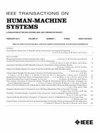Emotion Recognition of Playing Musicians From EEG, ECG, and Acoustic Signals
IF 4.4
3区 计算机科学
Q2 COMPUTER SCIENCE, ARTIFICIAL INTELLIGENCE
引用次数: 0
Abstract
This article investigated the automatic recognition of felt and musically communicated emotions using electroencephalogram (EEG), electrocardiogram (ECG), and acoustic signals, which were recorded from eleven musicians instructed to perform music in order to communicate happiness, sadness, relaxation, and anger. Musicians' self-reports indicated that the emotions they musically expressed were highly consistent with those they actually felt. Results showed that the best classification performances, in a subject-dependent classification using a KNN classifier were achieved by using features derived from both the EEG and ECG (with an accuracy of 98.11%). Which was significantly more accurate than using ECG features alone, but was not significantly more accurate than using EEG features alone. The use of acoustic features alone or in combination with EEG and/or ECG features did not lead to better performances than those achieved with EEG plus ECG or EEG alone. Our results suggest that emotion detection of playing musicians, both felt and musically communicated, when coherent, can be classified in a more reliable way using physiological features than involving acoustic features. The reported machine learning results are a step toward the development of affective brain–computer interfaces capable of automatically inferring the emotions of a playing musician in real-time.从脑电图、心电图和声学信号识别演奏音乐家的情绪
这篇文章利用脑电图(EEG)、心电图(ECG)和声学信号研究了感受到的情绪和音乐传达的情绪的自动识别,这些信号是由 11 位音乐家录制的,他们被要求演奏音乐以传达快乐、悲伤、放松和愤怒。音乐家的自我报告表明,他们用音乐表达的情绪与他们的实际感受高度一致。结果显示,在使用 KNN 分类器进行的受试者分类中,同时使用脑电图和心电图特征的分类效果最好(准确率达 98.11%)。其准确率明显高于单独使用心电图特征的准确率,但并不明显高于单独使用脑电图特征的准确率。单独使用声学特征或将声学特征与脑电图和/或心电图特征结合使用,都不会比使用脑电图和心电图或单独使用脑电图时取得更好的效果。我们的研究结果表明,在连贯的情况下,使用生理特征比使用声学特征能更可靠地分类演奏音乐家的情绪检测,包括感觉和音乐交流。所报告的机器学习结果为开发能够实时自动推断演奏音乐家情绪的情感脑机接口迈出了一步。
本文章由计算机程序翻译,如有差异,请以英文原文为准。
求助全文
约1分钟内获得全文
求助全文
来源期刊

IEEE Transactions on Human-Machine Systems
COMPUTER SCIENCE, ARTIFICIAL INTELLIGENCE-COMPUTER SCIENCE, CYBERNETICS
CiteScore
7.10
自引率
11.10%
发文量
136
期刊介绍:
The scope of the IEEE Transactions on Human-Machine Systems includes the fields of human machine systems. It covers human systems and human organizational interactions including cognitive ergonomics, system test and evaluation, and human information processing concerns in systems and organizations.
 求助内容:
求助内容: 应助结果提醒方式:
应助结果提醒方式:


